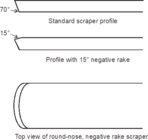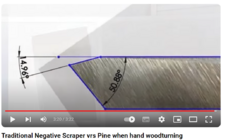Rather than spending big money for some of the new negative rake scrapers, would it be almost as good to grind a second angle on a traditional scraper? If so, what angle should the second grind be?
-
December 2025 Turning Challenge: Single Tree! (click here for details) -
Congratulations to Bob Henrickson, People's Choice in the November 2025 Turning Challenge (click here for details) -
Congratulations to Steven Gordon for "Dropped Ice Cream Cone" being selected as Turning of the Week for December 8, 2025 (click here for details) -
Welcome new registering member. Your username must be your real First and Last name (for example: John Doe). "Screen names" and "handles" are not allowed and your registration will be deleted if you don't use your real name. Also, do not use all caps nor all lower case.
You are using an out of date browser. It may not display this or other websites correctly.
You should upgrade or use an alternative browser.
You should upgrade or use an alternative browser.
Making a Negative Rake Scraper from a Traditional Scraper?
- Thread starter Bruce Reitman
- Start date
I look at it this way. Do I want to take a half hour or more grinding a big amount of steel off a traditional scraper I may want to use again, or do I want to do turning. I didn't give up on traditional scrapping.
That works fine. It will take some time to do but worth the effort. The bevels don’t have to be even in length, which will save you some time. Personally I use 35 degrees on both bevels. Some people use different bevel angles which is madness to me.Rather than spending big money for some of the new negative rake scrapers, would it be almost as good to grind a second angle on a traditional scraper? If so, what angle should the second grind be?
I turned a couple of 1" standard scrapers into negative rake. Tried different combinations of angles to see how they feel. I settled on 15 degrees for the top angle and 45 for the bottom. That leaves an included angle of 60 degrees. Doesn't seem like the top and bottom angles are as important as the included angle. Any included angle less than 80 will work. Higher included angles make the scraper feel easier to use and stays sharp a bit longer. Smaller included angles make the scraper more finicky, but the finish is better.
I suggest 10* to 20* for the top bevel. You want <90* included angle between top and bottom so you may need to grind the bottom bevel back depending on where it is now. You don't need to grind a wide bevel on the top. You can use the burr off the grinder or you can hone it smooth and raise a finer burr with a burnisher several times before grinding again. If you don't want to grind a traditional scraper you can use a skew with a burr, but that will require more frequent renewal because of the small included angle.
An effective negative angle burr will produce very fine shavings and need frequent touchup. A reground traditional scraper will work as well as one that is factory ground of the same quality steel. I don't see any disadvantage to different top and bottom bevels- you only grind the bottom once the top is established.
An effective negative angle burr will produce very fine shavings and need frequent touchup. A reground traditional scraper will work as well as one that is factory ground of the same quality steel. I don't see any disadvantage to different top and bottom bevels- you only grind the bottom once the top is established.
Last edited:
It is not necessary to grind skew profiles like most NR scrapers on sale. All of mine have the typical steep 70 °angle as the base grind and a 15° angle on the top.

I sharpen the scraper with a light grind on the 70° face and after a few months use, regrind the 15° angle.
I bought a heavy Raffan scraper advertised for box interiors but always had problems with catches. After regrinding the top I have not had any problems.

I sharpen the scraper with a light grind on the 70° face and after a few months use, regrind the 15° angle.
I bought a heavy Raffan scraper advertised for box interiors but always had problems with catches. After regrinding the top I have not had any problems.
john lucas
AAW Forum Expert
Me too richard. I use 35 degrees on both sides. I like being able to simply flip the tool over, grind off the old burr, flip and and put a new burr on.That works fine. It will take some time to do but worth the effort. The bevels don’t have to be even in length, which will save you some time. Personally I use 35 degrees on both bevels. Some people use different bevel angles which is madness to me.
As far as grinding an old tool down. Once you grind it to a negative rake you won't go back.
I tuned a couple of skews and the Benjamin's best bow scraper set off Amazon into various negative rake scrapers. For the price of those it's easy to grab a seconds set to keep as tradioscrapers too
I put 40 deg on both sides and like others I just flip it over from time to time to keep the edge balanced to the middle. I buy HSS blanks online, a lot cheaper than buying a pre ground tool, and grind the shape I want. You can get various widths and thicknesses depending on what you want. Some I put in sliding pocket sleeve handles and put a different grind on each end. Some I just use without a handle.
Thank you all for the responses on regrinding to make a negative rake. Very helpful.
Isn't that the definition of a skew? Same angles coming to a line.I put 40 deg on both sides and like others I just flip it over from time to time to keep the edge balanced to the middle. I buy HSS blanks online, a lot cheaper than buying a pre ground tool, and grind the shape I want. You can get various widths and thicknesses depending on what you want. Some I put in sliding pocket sleeve handles and put a different grind on each end. Some I just use without a handle.
The difference between a skew and a nrs can just be presentation angle. Skews make great scrapers, used properlyIsn't that the definition of a skew? Same angles coming to a line.
I make my own out of high quality HSS, often I just turn the scraper over and lift the handle to get the negative angle. But then I often deal with some incredibly hard wood such as Buloke, Deadfinish etc I have noticed this method is not so successful on softer wood species.
I've done this with several scrapers I have. But it does take some time and patience.
This link is a number of years old but contains some useful information
Just throwing this out there, Steve Jones Woodturner21 using a NRS on dry pine and making a LOT of shavings, counter to what I read most places about them not being for big stock removal. He has a couple at least of similar videos on NRS. Steve's NRS His grind:


If you want to convert a regular scraper to a negative rake scraper, there is really no need to grind the top bevel all the way back like you see on commercial negative rake scrapers. You just need enough of a top bevel to change the cutting angle. Literally something like 1/32" or 1mm will do the job. If you don't like it, you won't have much material to remove to go back to your old grind. And really, the bevel angle above or below isn't all that fussy.
